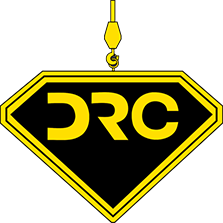When it comes to safe crane operation, safety procedures are essential from the beginning to the end. It isn’t just when lifting heavy loads or moving around the construction site, things could go wrong even as an operator is powering down a crane. This covers general safety measures and crane safety tips in a step-by-step guide to powering cranes on and off.
The Basics of Crane Activation and Deactivation
Activation vs Deactivation
Crane activation involves powering the crane “on” while deactivation turns the crane “off.” Each process involves starting/stopping various components like the hoist, boom, and controls. This process demands careful compliance with safety protocols from the Occupational Safety and Health Administration (OSHA) to prevent accidents.
11 Steps to Activate a Crane
It’s not as simple as jumping into the cap of a crane and turning the key. Trained operators, like those who receive their certifications at Diamond Rigging and Crane, know each one of these 11 steps forward and backward. It also essential that each operator knows the crane, or types of crane, completely before operating.
1. Pre-Operational Inspection
This is one of the most important steps to operating a crane safely. Conduct a thorough visual inspection of the crane, checking for any visible damage, wear, or loose components. Verify that all safety devices, such as limit switches and emergency stop buttons, are functioning properly. Make sure that the crane is free of any obstructions like power lines and that the area is clear.
2. Check the Power Supply
No one wants to get halfway through a job only to run out of fuel. So be sure to confirm that the crane is properly connected to its power source. Check electrical connections, fuel levels, or other power sources to ensure they are ready for operation.
3. Safety Briefing
It might be necessary to conduct a safety briefing with the crane operator and other relevant personnel. This is especially important for larger or more challenging loads. It may not be required on all projects, but taking the time to communicate with everyone involved could be very important.
4. Secure the Area
Use barriers and warning signs to secure the work area. This will help keep unauthorized people clear of the crane’s operating zone. This is especially important at busier work sites. For those who are working near, around, or with the crane, make sure that they are wearing proper personal protective equipment (PPE), including you!
5. Ready the Controls
Check that all the controls are in the neutral or off positions before starting. Don’t forget to fasten your seatbelt and adjust the seat and controls to be comfortable. It may seem strange, but like in a car, reaching all of the controls quickly is important to stay safe and avoid accidents.
6. Start the Crane
Turn the main power switch or key to the “on” position. Depending on the type of crane, it may be applicable to activate the crane’s hydraulic or electric systems according to the manufacturer’s instructions.
7. Perform a Functional Check
Test all crane controls, including the hoist, boom, and swing functions. Make sure that each part is operating smoothly and correctly. Don’t forget to check the operation of the brakes and other safety features.
8. Communicate with the Team
Confirm that you have clear communication with the signal person and ground crew, using hand signals or radio communication.
9. Raise the Boom or Load
Now it is time to put the crane into action. Gradually lift the boom or load, paying close attention to the crane’s behavior and any potential hazards. Throughout the project, it is the crane operator’s job to make sure that the crane remains stable and within the designated lifting limits.
10. Monitor and Adjust
Continuously monitor the crane’s performance and make adjustments as needed. Be prepared to shut down the crane immediately if anything unexpected or unsafe conditions arise.
11. Document and Report
Record any issues or observations in the crane’s logbook or maintenance records. Report any problems, equipment damage, or other necessary information for further action.
10 Steps to Deactivate a Crane
In comparison, deactivation is the process of turning the crane “off”. It is important to follow certain protocols to avoid malfunctions that could put people and equipment in danger when deactivating a crane. We recommend keeping the following 10 steps in mind.
1. Complete the Final Lift
Finish all lifting and moving operations for the day. The load should be safely placed and secured before beginning the shutdown process.
2. Return Crane to Neutral Position
Bring the crane’s hoist, boom, and controls to the neutral or resting positions. Be sure the crane is stable on the ground and all parts are properly aligned.
3. Power Down Systems
Turn off the crane’s hydraulic or electric systems according to the manufacturer’s instructions. This may involve switching off individual components or using a central power-down switch.
4. Secure the Crane
Check all safety devices, such as brakes and locking mechanisms. You want to make sure that the crane does not move unintentionally after shutdown.
5. Perform a Post-Operational Inspection
Conduct a visual inspection of the crane and its components, looking for any signs of damage or wear that occurred during operations.
6. Record Observations and Maintenance Needs
Document any issues or maintenance needs in the crane’s logbook or maintenance records. Notify the appropriate personnel if any repairs or adjustments are needed.
7. Lock Out and Tag Out
If the crane is to be left unattended or not in use for an extended period, lock out and tag out the main power source to prevent unauthorized use. This is very important, as a crane is a powerful and expensive piece of machinery.
8. Clean and Store Equipment
It is a good practice for any crane operator, no matter the job, to clean and store any tools, equipment, or materials used during operations. Cleaning the crane’s cab and controls will help keep them running smoothly, free from debris, and ready for the next use.
9. Communicate with the Team
Inform your team and project manager that the crane is shut down and no longer operational. A good team works together to make sure they leave knowing that everything is safe and secure.
10. Secure the Site
Before leaving, survey the area one last time. Make sure that the crane and surrounding area are left in a safe condition, with all barriers and warning signs in place to keep people out of harm’s way.
It is time to Activate Your New Career
If you are fascinated with cranes and enjoy learning about how to operate them, becoming a crane operator might be for you! Diamond Rigging and Crane, located in Baytown, TX, trains and NCCCO certifies some of the best operators in the industry. We are here to make your dream a reality!
Register for classes today!





